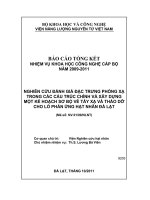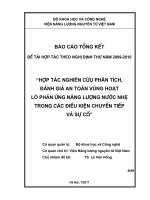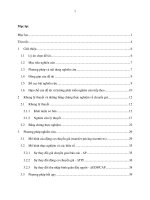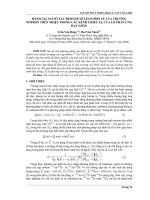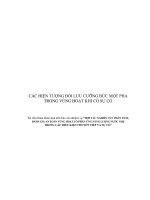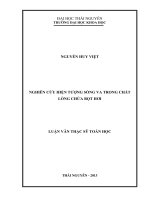Nghiên cứu hiện tượng chuyển pha trong vùng hoạt lò phản ứng hạt nhân
Bạn đang xem bản rút gọn của tài liệu. Xem và tải ngay bản đầy đủ của tài liệu tại đây (2.83 MB, 116 trang )
BỘ GIÁO DỤC VÀ ĐÀO TẠO
TRƯỜNG ĐẠI HỌC BÁCH KHOA HÀ NỘI
HOÀNG MINH GIANG
NGHIÊN CỨU HIỆN TƯỢNG CHUYỂN PHA TRONG VÙNG HOẠT
LÒ PHẢN ỨNG
LUẬN ÁN TIẾN SĨ CƠ HỌC
Hà Nội – 2016
BỘ GIÁO DỤC VÀ ĐÀO TẠO
TRƯỜNG ĐẠI HỌC BÁCH KHOA HÀ NỘI
LỜI CAM ĐOAN
Văn Hiền.
HOÀNG MINH GIANG
NGHIÊN
CỨU
HIỆNkết
TƢỢNG
CHUYỂN
PHAtrình
TRONG
VÙNG
Các số liệu,
những
luận nghiên
cứu đƣợc
bày trong
luậnHOẠT
văn
PHẢN
ỨNG
này trung thực và chƣa từng đƣợcLÒ
công
bố dƣới
bất cứ hình thức nào.
Tôi xin chịu trách nhiệm về nghiên cứu của mình.
GV Hướng dẫn
sinh
Chuyên ngành: CƠ HỌCNghiên
CHẤT cứu
LỎNG
Mã số: 62440108
Nguyễn Đông
LUẬN ÁN TIẾN SĨ CƠ HỌC
NGƢỜI HƢỚNG DẪN KHOA HỌC:
1. PGS.TS NGUYỄN PHÚ KHÁNH
2. TS TRẦN CHÍ THÀNH
Hà Nội – 2016
2
LỜI CAM ĐOAN
Tôi xin cam đoan luận án là công trình nghiên cứu của bản thân tôi dƣới
sự hƣớng dẫn của tập thể giáo viên hƣớng dẫn.
Các kết quả nêu trong luận án là trung thực, không sao chép của bất kỳ
công trình nào và chƣa từng đƣợc công bố trong bất kỳ công trình nào khác.
Hà Nội, ngày 27 tháng 4 năm 2016
NGHIÊN CỨU SINH
HOÀNG MINH GIANG
Hƣớng dẫn 1
PGS. NGUYỄN PHÚ KHÁNH
Hƣớng dẫn 2
TS. TRẦN CHÍ THÀNH
3
LỜI CẢM ƠN
Trƣớc hết, tôi xin bày tỏ lòng kính trọng và biết ơn tới: PGS Nguyễn Phú
Khánh và TS Trần Chí Thành, những ngƣời thày đã trực tiếp hƣớng dẫn, giúp đỡ
tôi trong quá trình học tập và thực hiện luận án.
Tôi xin chân thành cảm ơn các thày cô tại Bộ môn Kỹ thuật Hàng không
và Vũ trụ, Viện Cơ khí Động lực; cảm ơn TS Lê Văn Hồng, Viện Năng lƣợng
Nguyên tử Việt Nam, chủ nhiệm đề tài độc lập cấp nhà nƣớc (mã số
ĐTĐL.2011-G/82) ―Nghiên cứu, phân tích, đánh giá và so sánh hệ thống công
nghệ nhà máy điện hạt nhân dùng lò VVER-1000 giữa các loại AES-91, AES92 và AES-2006‖, các đồng nghiệp Hoàng Tân Hƣng, Trung tâm An toàn hạt
nhân, Nguyễn Hữu Tiệp, Trung tâm Năng lƣợng hạt nhân, Viện Khoa học và Kỹ
thuật hạt nhân đã giúp đỡ, tạo điều kiện để tôi có thể hoàn thành luận án này.
Tôi cũng xin trân trọng cảm ơn Ban lãnh đạo Viện Khoa học và Kỹ thuật
hạt nhân, Viện đào tạo Sau đại học của Trƣờng Đại học Bách Khoa Hà Nội đã
cử tôi đi đào tạo cũng nhƣ tạo điều kiện thuận lợi trong quá trình thực hiện luận
án.
Hà nội ngày 27/4/2016
Nghiên cứu sinh
Hoàng Minh Giang
4
STUDY ON PHASE CHANGE IN THE CORE OF
NUCLEAR REACTOR
5
TABLE OF CONTENTS
Abbreviations and Nomenclature ...............................................................................................................8
List of Tables ..............................................................................................................................................12
List of Figures .............................................................................................................................................14
Overview ....................................................................................................................................................17
Chapter 1. Introduction to research work ...............................................................................................19
1.1 Status of nuclear power in the World and Vietnam ...........................................................................19
1.2 Brief overview of nuclear safety ........................................................................................................20
1.3 Core thermal hydraulics safety analysis in transient condition ..........................................................21
1.3.1 Role of void fraction in simulation of two phase flow ................................................................24
1.3.2 Experiment overview for bundle of sub channel analysis ...........................................................25
1.3.3 Void fraction prediction study .....................................................................................................26
1.4 VVER technology understanding related to this study ......................................................................27
1.5 Thesis objectives ................................................................................................................................29
1.5.1 Studied object ..............................................................................................................................30
1.5.2 Scope of study .............................................................................................................................30
1.6 Thesis outline .....................................................................................................................................31
Chapter 2. Overview of phase change models in code theories with different scales ...........................33
2.1 Multi code and multi scales approach to PWR thermal hydraulic simulation ...................................33
2.1.1 Neutron codes and thermal hydraulics codes ..............................................................................33
2.1.2 Different scale of thermal hydraulic codes..................................................................................34
2.1.3 Different thermal hydraulic modeling approaches ......................................................................36
2.2 Phase change models in system code RELAP5 .................................................................................38
2.3 Phase change models in sub channel code CTF .................................................................................40
2.3.1 Evaporation and condensation induced by thermal phase change ..............................................40
2.3.2 Evaporation and condensation induced by turbulent mixing and void drift................................42
2.4 Phase change models in meso scale code CFX ..................................................................................42
2.4.1 Evaporation at the wall ................................................................................................................42
2.4.2 Condensation model in bulk of liquid .........................................................................................43
2.5 Conclusions ........................................................................................................................................44
Chapter 3. Phase change models verification and assessment by numerical simulation .....................45
3.1 Brief information of VVER-1000/V392 ............................................................................................45
3.2 Verification of RELAP5 simulation models for VVER-1000/V392 reactor with SAR.....................47
3.2.1 Nodalization scheme ...................................................................................................................48
3.2.2 Verification of modeling through steady-state study ..................................................................48
3.2.3 Verification through accident case study ....................................................................................49
6
3.3 CTF models verification and assessment with BM ENTEK tests ......................................................51
3.3.1 ENTEK BM facility ....................................................................................................................51
3.3.2 Modeling by CTF ........................................................................................................................53
3.3.3 Results and discussions ...............................................................................................................53
3.4 Verification CFX models with PSBT sub channel tests.....................................................................59
3.4.1 PSBT test section for single sub channel ....................................................................................60
3.4.2 Mesh generation study ................................................................................................................61
3.4.3 Solver convergence study............................................................................................................63
3.4.4 Mesh refinement study ................................................................................................................64
3.4.5 Sensitivity study on physical models ..........................................................................................68
3.4.6 Assessment of CFX and CTF modeling results in comparison with PSBT single channel ........79
3.4.7 Discussion on CTF and CFX void fraction predictions ..............................................................82
3.4.8 Improvement of CFX void fraction prediction in saturated region .............................................84
3.5 Conclusions ........................................................................................................................................86
Chapter 4. Void fraction prediction in hot channel of VVER-1000/V392 ............................................88
4.1 Calculation Diagram ..........................................................................................................................88
4.2 Power distribution calculation by MCNP5 code ................................................................................90
4.3 LOCAs simulation by RELAP5 code ................................................................................................93
4.4 Void fraction prediction in hot channel during transient by CTF code ..............................................96
4.4.1 VVER-1000/V392 void fraction prediction by CTF ...................................................................96
4.4.2 Discussion on RELAP5 and CTF void fraction predictions .......................................................98
4.5 Void fraction prediction in single channel by CFX code .................................................................100
4.5.1 Mesh refinement study ..............................................................................................................101
4.5.2 Void fraction prediction calculated by CFX along sub channel................................................102
4.6 Void fraction prediction in bundle of channel calculated by CFX code ..........................................104
4.7 Conclusions ......................................................................................................................................107
Conclusions and proposals ......................................................................................................................108
Achievements and new findings given by the thesis ..............................................................................108
Proposal of future work ..........................................................................................................................110
References .................................................................................................................................................112
List of Author’ papers and report ..........................................................................................................116
7
Abbreviations and Nomenclature
Abbreviations
VVER
VVER-1200/V491
VVER-1000/V392
VINATOM
TSO
DID
PWR
SAR
NRA
RIAs
LOFAs
LOCAs
DNB
DNBR
Castellana
EPRI
BM ENTEK
RBMK-1000
PSBT
CTF
RELAP5
COBRA-TF
RELAP-3D
MARS-3D
Belene
Ansys CFX
CFX
PARCS
ITT
0D, 1D, 2D
CHF
TH
RANS
A Type of Pressurized Water Reactor developed by Russia
A type of Russia reactor with capability of 1200 MWe
A type of Russia reactor with capability of 1000 MWe
Vietnam Atomic Energy Institute
Technical Support Organization
Defend in depth policy in nuclear power plant design
Pressurized Water Reactor
Safety Analysis Report of nuclear power plant
Nuclear Regulatory Authority
Reactivity insertion accident
Loss of coolant flow
Loss of coolant accident
Departure of nucleate boiling
Departure of nucleate boiling ratio
The 4 x 4 square rod bundle test for fuel rod in Columbia University
(USA)
Electric Power Research Institute
The BM Facility at the Research and Development Institute of Power
Engineering (RDIPE; a.k.a., ENTEK and NIKIET) models the forced
circulation circuit of RBMK type reactors
A type of Russia reactor of 1000 MWe with transliteration of Russian
characters for graphite-moderated boiling-water-cooled channel-type
reactor
OECD/NRC Benchmark based on Nuclear Power Engineering
Corporation (NUPEC, Japan) PWR sub channel and bundle tests
A version of COBRA-TF improved by Pennsylvania State University
(USA)
System code developed by Information Systems Laboratories, Inc.
Rockville, Maryland Idaho Falls, Idaho
Coolant-Boiling in Rod Arrays—Two Fluids (COBRA-TF) is a Thermal
Hydraulic (T/H) simulation code designed for Light Water Reactor (LWR)
vessel analysis developed by Pacific Northwest Laboratory
Newest version of RELAP5 with coupling with COBRA-TF
Newest version of MARS with coupling with COBRA-TF
A site for nuclear power plant project in Bulgaria
A Computational Fluid Dynamics developed by Ansys
Same as Ansys CFX
A code for neutron kinetic calculation
interface tracking technique
Dimension of spatial averaging
Critical Heat Flux
Thermal hydraulics
Reynolds-averaged Navier–Stokes Simulation
8
LES
MSLB
PTS
CFD
DI
FI
SI
U-RANS
T-RANS
meso scale
ECCS system
LBLOCAs
SBO
SG
SG PHRS
HA-2
HA-1
PCT
DBA
MCPL
LOOP
DG
SAR SG
OECD/NRC BFBT
αcrit
Large Eddy Simulation
Main steam line break
Pressurize Thermal shock
Computational Fluid Dynamics
Deterministic Interface
Filtered Interface
Statistical Interface
Unsteady flow
Transient flow
The spatial scale with size around 1mm and less simulated with RANS
Emergency Core Cooling System
Large break for loss of coolant accident
Station black out
Steam Generator
Passive Heat Removal through Steam Generator
Secondary stage of Hydro accumulators
First stage of Hydro accumulators
Peaking temperature of cladding
Design Base Accident
Main Coolant Pipe line
Loss of offsite power
Diesel Generator
SG Active Heat Removal System
UPEC BWR Full-size Fine-mesh Bundle Test (BFBT) Benchmark
Void fraction corresponding with critical heat flux correlation
9
Nomenclature
As
Ax
Cpl
Cpv
̅
h
h
h
h
h
hc
hl*
h
hg
h
h
̇
̇
Ρl
Qwf
Qwif, Qboil
Tg
TS
Tcrit
Tl, Tf
rb
̅
Γ’’’
Sub-cooled vapor interfacial area per unit volume (m-1)
Super-heated liquid interfacial area per unit volume (m-1)
Super-heated vapor interfacial area per unit volume (m-1)
Conductor surface area in mesh cell (m2)
Mesh-cell area, X normal (m2)
Liquid specific heat, constant pressure (J/kg.K)
Vapor specific heat, constant pressure (J/kg.K)
Mixing mass flux (kg/m2.s)
Vapor saturation enthalpy (J/kg)
Sub-cooled liquid interface heat transfer coefficient (W/m2.K)
Sub-cooled vapor interface heat transfer coefficient (W/m2.K)
Super-heated liquid interface heat transfer coefficient (W/m2.K)
Super-heated vapor interface heat transfer coefficient (W/m2.K)
Chen correlation heat transfer coefficient (W/m2.K)
Liquid enthalpy (J/kg)
Liquid saturation enthalpy (J/kg)
Vapor enthalpy (J/kg)
Vapor interface heat transfer coefficient (W/m3..K)
Liquid interface heat transfer coefficient (W/m3..K)
Mass exchange due to drift model (kg/s)
Mass exchange of phase k (kg/m2.s)
Density of liquid (kg/m3)
Wall heat transfer to liquid (W)
Wall heat transfer to liquid for convection (W)
Wall heat transfer to liquid for vaporization (W)
Vapor temperature (K)
Saturated temperature (K)
Critical heat flux temperature (K)
Liquid temperature (K)
Bubble diameter (m)
Void fraction of phase k induced by sub channel i
Equilibrium quality void fraction
Two phase turbulent mixing coefficient
Density of phase k in sub channel i (kg/m3)
Liquid density (kg/m3)
Vapor density (kg/m3)
Mixing density (kg/m3)
Volumetric mass flow rate (kg/m3.s)
Vapor generation from near wall (kg/m3.s)
Total Vapor Generation (kg/m3.s)
Mesh-cell axial height (m)
Surface tension (N/m)
Fluid viscosity (Pa.s)
Pressure (Pa)
10
Γ’’
Tw
Tchf ,Tcrit
Re
Pr
Nu
n
kl ,
hv
hnb
hl
hg
hfc
hf
hc
g
FChen
f
Dh
Cp
Ax
As
Fo
̅
,𝑟
𝑞
𝑞
𝑞
𝑞
𝑞
̅
Evaporation rate (kg/m2.s)
Wall surface temperature (K)
Critical heat flux temperature (K)
Reynolds number
Prandtl number
Nusselt number
Wall nucleation site density (m-2)
Liquid thermal conductivity (W/m.K)
Vapor enthalpy (J/kg)
Nucleate-boiling heat transfer coefficient (W/m2.K)
Liquid enthalpy (J/kg)
Vapor saturation enthalpy (J/kg)
Forced-convective heat transfer coefficient (W/m2.K
Liquid saturation enthalpy (J/kg)
Chen correlation heat transfer coefficient (W/m2.K)
Gravitational acceleration (m/s2)
Chen Reynolds number factor
Bubble detachment frequency (s-1)
Hydraulic diameter (m)
Specific heat, constant pressure (J/kg.K)
Mesh-cell area, X normal (m2)
Conductor surface area in mesh cell (m2)
Mesh-cell axial height (m)
Inverse Martinelli factor
Liquid density (kg/m3)
Fourier number
Vapor density (kg/m3)
Mixing density (kg/m3)
Void fraction
Volumetric heat transfer from the wall (W/m3)
Total wall heat flux (W/m2)
Quenching heat flux (W/m2)
Evaporative heat flux (W/m2)
Convective heat flux (W/m2)
Local mean bubble diameter (m)
Saturation temperature (K)
Liquid temperature (K)
Mesh-cell area of phase k (m2)
Chen suppression factor
Heat transfer per volumetric unit (W/m3)
Mixing mass flux (kg/m3.s)
Area influence factors
11
List of Tables
Table 1.1 Multiple levels of protection from DID approach (source [45]) ............................................20
Table 1.2 Content of Safety Analysis Reports (source [45]) .................................................................21
Table 1.3 Castellana 4x4 test characteristics (source [29]) ....................................................................25
Table 1.4 EPRI 5x5 characteristics for test 74 and test 75(source [29]) ................................................25
Table 1.5 Geometry and power shape for Test Assembly B5, B6, and B7 (Source [1]) .......................25
Table 2.1 Main characteristics of codes with four different scales (source [11]) ..................................36
Table 2.2 Main characteristics modeling approaches for three main types of single-phase CFD .........37
Table 3.1 Main technical characteristics of VVER-1000/V392 (source[36]) ........................................46
Table 3.2 Comparison of steady-state of VVER-1000/V392.................................................................48
Table 3.3 Boundary conditions for event number 3 (source [35]). ........................................................49
Table 3.4 Chronological sequence of Event 3 from SAR [35] and this study .......................................50
Table 3.5 Setting for base case and sensitivity cases according to test 01 and test 17 ...........................53
Table 3.6 Base case void fraction distribution calculations versus experiment for cases at 3MPa. ......54
Table 3.7 Base case void fraction distribution calculations versus experiment for cases at 7MPa. ......54
Table 3.8 Deviation of void fraction distribution calculation results versus experiment .......................55
Table 3.9 Deviation of void fraction distributions on input uncertainties ..............................................58
Table 3.10 Maximum deviation of void fraction distribution on input parameters versus base case ....58
Table 3.11 Experimental uncertainties on input parameters ..................................................................60
Table 3.12 Test Conditions for Steady-State Void Measurement of selected runs ................................61
Table 3.13 Mesh characteristics .............................................................................................................62
Table 3.14 y+ predicted by Mesh 1.........................................................................................................62
Table 3.15 y+ predicted by Mesh 2.........................................................................................................62
Table 3.16 y+ predicted by Mesh 3.........................................................................................................63
Table 3.17 Two phase flow model setting .............................................................................................63
Table 3.18 Average void fraction calculations between three meshes and experiment value ...............64
Table 3.19 Radial distribution of pressure and temperature for different refinement meshes ...............64
Table 3.20 Radial distribution of velocity and void fraction for different refinement meshes ..............65
Table 3.21 Average void fraction calculation at given cross section with or without modeling ...........69
Table 3.22 Calculation results of average void fraction .........................................................................73
Table 3.23 Average void fraction calculation with different scale of bubble mean diameter ................75
Table 3.24 Average void fraction calculation results with different Nref ..............................................77
Table 3.25 Average void fraction calculation results with different bubble departure diameters ..........78
12
Table 3.26 Average void fraction calculation results with different Nusselt number correlations ........79
Table 3.24 CFX and CTF results comparisons versus experiment void fraction ...................................80
Table 3.25 Comparison of CFX and CTF results and experiment void fraction in saturated region ....81
Table 3.26 Comparison of CFX and CTF results versus experiment in case of high pressure ............81
Table 3.27 Comparison of CFX and CTF results and experiment void fraction ...................................82
Table 3.28 Void fraction and temperature super heating before and after calibration ...........................85
Table 4.1 Main technical characteristics of fuel assembly for VVER-1000/V392 ................................90
Table 4.2 Case studies for void fraction prediction................................................................................94
Table 4.3 Boundary condition of LOCA coupled with SBO for analysis ..............................................94
Table 4.4 Data related to phase change of interfacial area for case LB01002B at 15s of transient .......99
Table 4.5 Cases for void fraction prediction in single channel by CFX ..............................................101
Table 4.6 Average void fraction for different meshes..........................................................................102
Table 4.7 Void fraction prediction by CTF and CFX at downstream of channel at z = 3.48m ...........102
Table 4.8 Sub cooled selected regions for CFX investigation ............................................................105
Table 4.9 Saturated selected regions for CFX investigation ................................................................105
13
List of Figures
Figure 1.1 Nuclear power generation by country in 2013 (source [46]) ................................................19
Figure 1.2 Multiple physical barriers in DID policy (source [45]) ........................................................22
Figure 1.3 Heal flux versus temperature difference for pool boiling heat transfers (source [31]) .........23
Figure 1.4 Types of boiling flow crisis (source [25]).............................................................................23
Figure 1.5 Critical heat flux in uniformly core (source [25]) .................................................................24
Figure 1.6 Development of VVER nuclear reactor technology chart [32] .............................................28
Figure 1.7 Multi-scale analysis of reactor thermal hydraulics (source [11]) .........................................29
Figure 1.7 (a) temperature distributions in a cylindrical fuel pin, (b) flow regime ................................31
Figure 2.1 Relations between MCNP5, system code RELAP5 and component code CTF ...................33
Figure 2.3 System code capabilities for reactor thermal hydraulics (source [7]) ...................................34
Figure 2.4 Control volume and axial flow area defined in sub channel code ........................................35
Figure 2.6 The tree of two-phase thermal hydraulic modeling approaches (source [11])......................38
Figure 2.7 Schematic of vertical flow regime map in RELAP5(source [19]) ........................................40
Figure 2.8 CTF normal-wall flow regime maps (source [38]) ...............................................................41
Figure 3.1 Side view of primary system of VVER-1000/V392 (source [36]) .......................................46
Figure 3.2 Primary system and safety system for VVER-1000/V392 (source [37])..............................47
Figure 3.3 VVER-1000/V392 nodalization schemes in this study.........................................................48
Figure 3.4 (a) Cladding temperature from calculations, (b) Cladding temperature from SAR ..............51
Figure 3.5 Test section (Heat Release Zone, φ is diameter in mm) .......................................................52
Figure 3.6 BM ENTEK modeling by CTF ............................................................................................53
Figure 3.7 Radial void distribution of the test T04 ................................................................................56
Figure 3.8 Cross mass flow due to turbulent mixing and void drift .......................................................56
Figure 3.9 Maximum and minimum voiding curves versus experiment ................................................57
Figure 3.10 Maximum and minimum voiding curves versus experiment ..............................................57
Figure 3.11 Uncertainty void fraction distributions for test T01............................................................58
Figure 3.12 Test section for central sub channel void distribution measurement (source [1]) ..............60
Figure 3.13 Cross section of three proposed meshes .............................................................................62
Figure 3.14 Base line for radial distribution investigation .....................................................................64
Figure 3.15 S14326 Radial distribution of void fraction........................................................................66
Figure 3.16 S16222 Radial distribution of void fraction........................................................................66
Figure 3.17 S12211 Radial distribution of void fraction........................................................................67
Figure 3.18 S14326 Axial sub channel distribution of void fraction .....................................................67
14
Figure 3.19 S16222 Axial sub channel distribution of void fraction .....................................................68
Figure 3.20 S12211 Axial sub channel distribution of void fraction .....................................................68
Figure 3.21 S14326 Radial distribution of void fraction of full sub models ..........................................70
Figure 3.22 S144411 Radial distribution of void fraction of full sub models ........................................70
Figure 3.23 S12211 Radial distribution of void fraction of full sub models ..........................................71
Figure 3.24 S14411 Radial distribution of void fraction of full sub models ..........................................71
Figure 3.25 S16222 Radial distribution of void fraction of full sub models ..........................................72
Figure 3.26 S14326 Radial distribution of void fraction of full sub models ..........................................72
Figure 3.27 S11222 Radial distribution of void fraction with different turbulent .................................73
Figure 3.28 S16222 Radial distribution of void fraction with different turbulent .................................74
Figure 3.29 S14326 Radial distribution of void fraction with different turbulent .................................74
Figure 3.30 S12211 Radial distribution of void fraction with different scale ........................................75
Figure 3.31 S16222 Radial distribution of void fraction with different scale ........................................76
Figure 3.32 S14326 Radial distribution of void fraction with different scale ........................................76
Figure 3.33 (a) Bubble departure size, (b) Heat flux partition with different models ............................79
Figure 3.34 Temperature distribution along axial and radial channel ....................................................84
Figure 3.35 Temperature superheating and void fraction before and after calibration ..........................86
Figure 4.1 Two-phase thermal hydraulic modeling for RELAP5, CTF and CFX .................................88
Figure 4.2 Geometry of sub channel in VVER-1000/V392 fuel assembly ............................................89
Figure 4.3 VVER-1000/V392 void fraction prediction chart using multi codes and multi scales .........90
Figure 4.4 The sixth of core loading pattern and whole core geometry for MCNP5 simulation ...........91
Figure 4.5 Relative power distribution in the sixth of the whole core ...................................................92
Figure 4.6 Distribution of relative power along axial hot channel .........................................................93
Figure 4.7 Distribution of relative power in the hot channel .................................................................93
Figure 4.8 (a) Whole fuel assembly simulated as hot channel and (b) the active part ...........................95
Figure 4.9 Average void fraction calculated by RELAP5 on exit of active region in hot channel ........95
Figure 4.10 Taken twelfth of whole bundle for void fraction prediction. ..............................................96
Figure 4.11 Cross section of CTF modeling for the selected part of the whole bundle .........................97
Figure 4.12 Void fraction prediction by CTF and RELAP5 for LBLOCAs ..........................................97
Figure 4.13 Void fraction prediction by CTF and RELAP5 for SBLOCAs ..........................................98
Figure 4.14 Total vapor generation rate and vapor generation rate near wall ........................................98
Figure 4.15 Total vapor generation rate and vapor generation rate near wall ........................................99
Figure 4.16 Three meshes used to simulate geometry of single channel .............................................101
Figure 4.17 Average void fraction along channel with different meshes.............................................102
15
Figure 4.18 Axial sub channel void fraction prediction by CFX and CTF ..........................................103
Figure 4.19 (a) Overview of mesh (b) Zooming of mesh ....................................................................105
Figure 4.20 Four cases with specific timing for study by CFX...........................................................105
Figure 4.21 Improvement by CFX in left pictures and upper and lower bounds in right pictures .......107
16
Overview
Phase change in the nuclear reactor core is related to safety criteria such as Departure of
Nucleate Boiling (DNB) during normal and transient conditions. So that, a lot of computer
codes with verification and validation against experiment are used to investigation of thermal
hydraulics behavior of vertical boiling flow in core channel with system and component
scales. Until now, even many studies on boiling flow are implemented in CFD scale codes,
but their utilization to specific nuclear reactor is not yet applied. Thus, the utilization of many
codes including CFD scale (Ansys CFX) to investigate void fraction in hot channel of VVER1000/V392 reactor core is studied in this work. Due to VVER-1000/V392 nuclear reactor is a
candidate for Ninh Thuan 1 nuclear power project, so that the understanding of VVER’s
reactor technologies including research works of this thesis is important to develop
competence of nuclear safety in Vietnam.
In this thesis, the numerical simulation is used to investigate boiling flow in the core channel
of VVER-1000/V392 reactor with verification and validation against experiment with similar
Pressurized Water Reactor conditions.
The thesis includes four chapters together a conclusion in the last. Chapter 1 mentions about
introduction that leads to motivation of this study. Chapter 2 presents the methodology related
to multi scale analysis along with the code theories at different scale for RELAP5, CTF and
Ansys CFX with focus on phase change models. The verification and assessment of modeling
used in these codes versus experiment data are presented in chapter 3. The system simulation
results are compared with those in SAR documents. The assessment of CTF code is
implemented by simulation BM ENTEK experiment tests which is an International Standard
Benchmark to investigate boiling flow through Russian fuel bundle of RBMK reactor. The
meso scale code Ansys CFX is verified with PSBT single sub channel which is also an
International Standard Benchmark as well. Chapter 4 presents the simulation of VVER1000/V392 by three scales with system, component and CFD codes corresponding with
RELAP5, CTF and Ansys CFX, respectively. Void fraction in hot channel of the core is
predicted by utilization of CTF and Ansys CFX codes.
It is summarized several main contributions from the thesis as following:
It is proposed a reality of best estimate approach in void fraction prediction by
utilization of multi codes and multi scale including MCNP5, RELAP5, and CTF for
analysis of void fraction behavior in the core during transient.
It is established a procedure of utilization of CTF and Ansys CFX for improvement of
void fraction prediction as following: (a) at sub cooled region, corresponding with
small bubble flow regime, Ansys CFX results is used; (b) in saturated boiling region,
CTF and Ansys CFX void fraction curves along the channel is used as upper bound
and lower bound to predict void fraction in the core.
It is found that, in saturated boiling region, the wall boiling model built in Ansys CFX
is incorrectly partitioned heat flux to corresponding parts in convective, quenching and
evaporative. This issue causes Ansys CFX gives under prediction of void fraction in
saturated boiling region. It is proposed a calibration for bubble departure diameter and
17
maximum area fraction to improve void fraction prediction by Ansys CFX in saturated
region.
18
Chapter 1. Introduction to research work
1.1 Status of nuclear power in the World and Vietnam
Nuclear technology uses the energy released by splitting the atoms of certain elements. After
Second World War, nuclear technology turned to peaceful purposes of nuclear fission for
power generation. Today, as updated in February 2015 [46], the world produces as much
electricity from nuclear energy as it did from all sources combined in the early years of
nuclear power. Civil nuclear power now can boast over 16,000 reactor years of experience
and supplies almost 11.5% of global electricity needs. The 31 countries host over 435
commercial nuclear power reactors with a total installed capacity of over 375,000 MWe as
illustrated in Figure 1.1. About 70 further nuclear power reactors are under construction,
equivalent to 20% of existing capacity, while over 160 are firmly planned, and equivalent to
half of present capacity.
Figure 1.1 Nuclear power generation by country in 2013 (source [46])
After Fukushima accident in 2011, it is needed to improve performance from existing nuclear
reactor safety, so that stress test is implemented for every reactor to ensure that it can stand
with design extension conditions as it occurred in Fukushima.
Nuclear power program in Vietnam was confirmed by National Assembly Decision on
November 25, 2009 with a plan to build four nuclear power units. Russian VVER technology
was selected for the first site and the VVER-1200/V491 and VVER-1000/V392 nuclear
reactors were considered as the candidates. In parallel with capacity building for nuclear
19
power infrastructure, Vietnam Atomic Energy Institute (VINATOM) has been assigned to
develop technical competence of nuclear safety and, in future, it will become a main
Technical Support Organization (TSO) for nuclear safety in Vietnam.
1.2 Brief overview of nuclear safety
In any nuclear reactor, nuclear safety includes three primitive principals related to all
operational conditions: (a) control of reactivity, (b) heat removal from the core to ultimate
heat sink and (c) confinement of fission products in case of accident occurrence.
Requirements of nuclear safety enforce the utilization of defend in depth (DID) policy in
nuclear power plant design. In general, defense in depth policy is implemented by multiple
levels of protection (Table 1.1) and protection barriers
Table 1.1 Multiple levels of protection from DID approach (source [45])
Levels
Level 1
Objective
Prevention of abnormal operation and
failures
Level 2
Control of abnormal operation and
detection of failures
Level 3
Control of accidents within the design
basis
Control of severe plant conditions,
including prevention of accident
progression and mitigation of the
consequences of severe accidents
Mitigation of radiological consequences
of significant release of radioactive
materials
Level 4
Level 5
Essential Mean
Conservative design and high
quality in construction and
operation
Control, limit & protection
systems and other surveillance
feature
Engineered safety features and
accident procedures
Complementary measures and
accident managements
Off-site emergency response
For PWR reactors at power operation, the barriers confining the fission products are typically:
(a) fuel matrix, (b) fuel cladding, (c) boundary of the reactor coolant system, (d) containment
system as shown in Figure 1.2. The nuclear utility owner must provide and demonstrate that
their technical plan design is satisfied for the safety requirements through safety analysis
report (SAR) which is reviewed and approved by nuclear regulatory authorities (NRA) and
independent TSO. All main issues, related to nuclear safety during plant life time, are
mentioned in SAR as illustrated in Table 1.2. Nuclear safety covers a wide range of issues
related to the plant including external hazards such as seismic, tsunami, flooding… and
internal hazard resulted from failure of structures, systems and components together with
human factor that are important to safety. In chapter 15 of SAR, thermal hydraulics safety
analysis is performed by simulation of different categories of postulated transient and design
base accident such as reactivity insertion accident (RIAs), loss of coolant flow (LOFAs) and
loss of coolant accident (LOCAs). The main system and other connected systems including
reactor coolant system (primary system), secondary system are modeled by system code that
20
can present the response of safety systems to protect and bring nuclear reactor to safety
condition.
Table 1.2 Content of Safety Analysis Reports (source [45])
Contents of Safety Analysis Reports
Chapter 1 – Introduction and General Description of Plant
Chapter 2 – Site Characteristics
Chapter 3 – Design of Structures, Components, Equipment, and Systems
Chapter 4 – Reactor
Chapter 5 – Reactor Coolant System and Connected Systems
Chapter 6 – Engineered Safety Features
Chapter 7 – Instrumentation and Controls
Chapter 8 – Electric Power
Chapter 9 – Auxiliary Systems
Chapter 10 – Steam and Power Conversion System
Chapter 11 – Radioactive Waste Management
Chapter 12 – Radiation Protection
Chapter 13 – Conduct of Operations
Chapter 14 – Initial Test Program and ITAAC-Design Certification
Chapter 15 – Accident Analysis
Chapter 16 – Technical Specifications
Chapter 17 – Quality Assurance
Chapter 18 – Human Factors Engineering
Chapter 19 – PSA and Severe Accidents
1.3 Core thermal hydraulics safety analysis in transient condition
It is shown that the second barrier plays a very important role due to the fact that it protects
fission product in fuel rod from release to primary system. Therefore, the peaking cladding
temperature in transient and accident conditions must be satisfied specific acceptance criteria.
The acceptance criteria introduced by IAEA for transient condition in [21] is briefly
formulated as below:
(1) The probability of a boiling crisis anywhere in the core is low. This criterion is typically
expressed by the requirement that there is a 95% probability at the 95% confidence level that
the fuel rod does not experience a departure from nucleate boiling (DNB). The DNB
correlation used in the analysis needs to be based on experimental data that are relevant to the
particular core cooling conditions and fuel design.
(2) The pressure in the reactor coolant and main steam systems is maintained below a
prescribed value (typically 110% of the design pressure).
(3) There is no fuel melting anywhere in the core.
21
Figure 1.2 Multiple physical barriers in DID policy (source [45])
Based on the first criteria, core thermal hydraulics is related to boiling crisis during transient
condition. As mentioned in [31], the relation between heat flux from the wall and temperature
difference from wall and fluid for pool boiling heat transfer is illustrated in Figure 1.3. The
point ―C‖ in Figure 1.3 is called burnout point due to departure of nucleate boiling (DNB)
reached. Thus, if heat flux from the wall increases to reach the burnout point (or also called
DNB point) and results in a numerous of bubbles which begin to coalesce and clump near
heating surface (the vapor covering the surface acts as a heat insulator). The blanket of vapor
covering heating surface limits heat transfer from wall to liquid and makes cladding
temperature higher that lead to violate acceptance criteria. This is known as partial nucleate
boiling and must be avoid or must be limited as the first criteria mentioned above in nuclear
reactor during normal and transient operation condition, respectively. As known in Figure 1.3,
if heat flux reaches the burnout point, heat transfer mode is unstable in transition from
nucleate boiling to film boiling with corresponding increase in wall temperature. Thus, the
boiling crisis, in which cladding temperature increases dramatically, corresponds to a sudden
drop in heat transfer coefficient from wall
due to change boiling mechanism from nucleate
boiling to film boiling. The boiling crisis is presented by many names such as burnout, critical
heat flux and DNB. The boiling crisis in flowing coolant is more complicated than pool
boiling due to added effects of forced convection and bubbles clouding that tend to cover
heating surface.
22
Figure 1.3 Heal flux versus temperature difference for pool boiling heat transfers (source [31])
The boiling crisis in coolant flow is closely related to flow pattern and void fraction. In [25], it
is mentioned about two typical phenomenon of interest in nuclear safety as presented in
Figure 1.4.
Figure 1.4 Types of boiling flow crisis (source [25])
The left picture in Figure 1.4 shows the sub cooled or low quality DNB that is caused from
detachment of bubble from boundary layer. The picture in the right of Figure 1.4 shows the
burnout at high quality region that is caused from the liquid film covering heating surface
becomes ―dry out‖. The determination of critical heat flux at which DNB occurs is very
23
complicated due to the fact that it depends on many factors such as channel sharp, surface
condition, physical properties of the coolant and flow conditions. The most popular
correlation that ensures critical heat flux not exceeded during core operation is DNB ratio. It
is defined by the minimum ratio of the critical heat flux to the heat flux achieved in the core:
(1.1)
For the PWR, the DNBR > 1.3 for insurance of DNB not occurred. Figure 1.5 shows the
DNBR along axial channel in the uniform core.
Figure 1.5 Critical heat flux in uniformly core (source [25])
It is emphasized here that thermal hydraulics safety analysis in transient condition is dealing
with finding appropriate correlation that prevent DNB occurring in flow channel of the core.
Due to DNB occurrence is a very complicated mechanism but it is strictly related to void
fraction and flow regime, so that study on void fraction in transient condition is the first step
to approach understanding DNB mechanism.
1.3.1 Role of void fraction in simulation of two phase flow
The value of void fraction plays an important role in modeling of two phase flows. During
solving the conservation equations, the void fraction is calculated. Then, the flow regime is
defined based on the value of void fraction. For example, in CTF code, flow regimes are
determined based on the range of void fraction in normal wall models as illustrated in Figure
2.8 of this thesis. The normal wall flow regime map includes following flow regimes:
Small-bubble defined by void fraction below 0.2
Small-to-large bubble (Slug) defined by void fraction in range (0.2, 0.5)
Churn/turbulent defined by void fraction in range (0.5 αcrit)
Annular/mist defined by void fraction greater αcrit
Then each of individual flow regimes of normal wall map, the interfacial area, interfacial drag
and interfacial heat transfer are differently defined.
24
1.3.2 Experiment overview for bundle of sub channel analysis
Castellana tests
As mentioned in [29], the experimental Castellana allows for the evaluation of exit flow
quantities within a 4x4 test assembly. The brief information about this test is given in Table 3.
Table 1.3 Castellana 4x4 test characteristics (source [29])
Items
Rod Diameter, in. (cm)
Rod Pitch, in. (cm)
Rod to Wall spacing, in. (cm)
Ratio of heat flux
Hot rods (H)
Cold rods (C)
Heated length, in. (cm)
Assembly Dimensions in. x in., (cm x cm)
Value
0.422 (1.072)
0.555 (1.410)
0.148 (0.376)
1.0
0.86
60.0 (152.4)
2.383 x 2.383 (6.053 x 6.053)
EPRI tests
EPRI 5x5 tests allows for collection of exit flow quantities, as well as rod temperatures near
assembly exit. The brief information about this test is given in Table 4.
Table 1.4 EPRI 5x5 characteristics for test 74 and test 75(source [29])
Items
Rod Diameter, in. (cm)
Rod Pitch (x), in. (cm)
Rod Pitch (y), in. (cm)
Rod to Wall spacing (x), in. (cm)
Rod to Wall spacing (y), in. (cm)
Heated length, in. (cm)
Assembly Dimensions in. x in., (cm x cm)
Test 74
0.440 (1.118)
0.566 (1.438)
0.580 (1.473)
0.142 (0.361)
0.135 (0.343)
84.0 (213.4)
3.03 x 3.03 (7.7x7.7)
Test 75
0.440 (1.118)
0.590 (1.50)
0.580 (1.473)
0.130 (0.33)
0.135 (0.343)
84.0 (213.4)
3.03 x 3.03 (7.7x7.7)
BM ENTEK facility
The BM ENTEK facility [33] allows investigation void fraction along heating channel similar
to Russia RBMK-1000 bundle of fuel rods. The channel contains a 7- rod bundle made by
stainless steel with rod outer diameter of 13.5 mm, 1.25 mm wall thickness, and 7 m length.
The bundle is contained within a stainless steel pressure tube (80 mm outer diameter and 5
mm wall thickness) with inner diameter of 49 mm and 10.5 mm wall thickness.
PSBT Void Distribution Measurements
The PSBT facility [1] allows measurement of void fraction in both bundle of rods or in single
sub channel. Some brief information of PSBT rod bundle is given in Table 1.5.
Table 1.5 Geometry and power shape for Test Assembly B5, B6, and B7 (Source [1])
Item
Rod Array
Number of heater rods
Number of thimble rods
Heater rod outer diameter (mm)
Assembly B5
5x5
25
0
9.50
Assembly B6
5x5
25
0
9.50
Assembly B7
5x5
25
1
9.50
25

